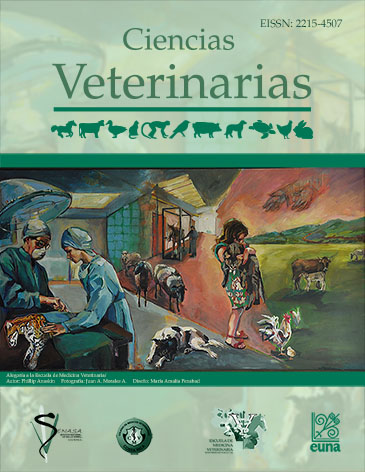Clinical case report: First laboratory-confirmed diagnosis of Rhodococcus equi in a foal in Costa Rica
DOI:
https://doi.org/10.15359/rcv.38-1.4Keywords:
Rhodococcus equi, 16SrRNA, foal bronchopneumonia, monetary impact, Costa RicaAbstract
Rhodococcus equi pneumonia is an important cause of morbidity and mortality in foals all over the world. Prevalence and/or virulence of bacteria is apparently low in Costa Rica since no outbreaks have been reported and suspicious cases show only mild to moderate clinical signs. However, there has never been a definitive diagnosis of the disease in Costa Rican horses. R. equi is a G (+) facultative intracellular bacteria causing pneumonia in young foals (up to 4-5 months of age). This paper refers to a 4-week old Friesian foal with a humerus fracture and omphalophlebitis that was referred to the Equine Hospital, National University, Costa Rica, for surgery. In the postoperatory period, the patient showed signs of moderate bilateral nasal discharge, cough, fever, lymphocytosis, and neutrophilia. The radiological evaluation of the thorax showed a bronchoalveolar pattern in the ventro cranial region of the lungs. The transtracheal aspirate cytology confirmed the presence of suppurative bronchopneumonia. The samples were aerobically cultured in Columbia agar + 5% blood at 37°C for 24h. The macroscopic, microscopic, and biochemical characteristics of the isolated bacteria, in addition to the partial sequencing of the “16SrRNA” gene, were compatible with R. equi. The foal was euthanized due to the humerus re-fracture before the R. equi diagnosis was confirmed. R. equi can potentially cause a severe monetary impact in the equine breeding industry; consequently, accurate diagnosis and treatments are important to avoid the emergence of resistant strains. Further studies are needed to determine the local prevalence of the pathogen and to evaluate its impact.
References
Al Akhrass, F., Al Wohoush, I., Chaftari, A.M., Reitzel, R., Jiang, Y., Ghannoum, M., Tarrand, J., Hachem, R. & Raad, I. 2012. Rhodococcus bacteremia in cancer patients is mostly catheter related and associated with biofilm formation. PLOS ONE 7(3): e32945. doi: 10.1371/journal.pone.0032945
Alhariri, M., Azghani, A. & Omri, A. 2013. Liposomal antibiotics for the treatment of infectious diseases. Expert Opin. Drug Del. 10(11): 1515-1532. doi: 10.1517/17425247.2013.822860
Álvarez, M., Güiris, D.M., Samayoa, Y.Y., Cruz, E. & Lira, I. 2001. Identification of aerobic bacteria from internal organs of Tapirus bairdii. Proceedings from First International Tapir Symposium, San José, Costa Rica, November 3-8, 2001. Abstract number 32. Instituto de Historia Natural y Ecología del Estado de Chiapas (IHNE) Apdo. Postal N°6, C.P. 29000, Tuxtla Gutiérrez, Chiapas, México.
Baptista, P.V., McCusker, M.P., Carvalho, A., Ferreira, D.A., Mohan, N.M., Martins, M. & Fernandes, A.R. 2018. Nano-Strategies to fight multidrug resistant bacteria - “A battle of the titans”. Front. Microbiol. 9: 1441. doi: 10.3389/fmicb.2018.01441
Chaffin, M.K., Cohen, N.D., Martens, R.J., O’Connor, M. & Bernstein, R. 2011. Evaluation of the efficacy of gallium maltolate for chemoprophylaxis against pneumonia caused by Rhodococcus equi infection in foals. Am. J. Vet. Res. 72(7): 945-957. doi: 10.2460/ajvr.72.7.945
CLSI. 2015. M02-A12 Performance Standards for Antimicrobial Disk Susceptibility Tests; Approved Standard – Twelfth Edition, 12th Edition. Clinical and Laboratory Standards Institute, Wayne, Pennsylvania.
Cohen, N.D., Carter, C.N., Scott, M., Chaffin, K., Smith, J.L., Grimm, M.B., Kuskie, K.R., Takai, S. & Martens, R.J. 2008. Association of soil concentrations of Rhodococcus equi and incidence of pneumonia attributable to Rhodococcus equi in farms of central Kentucky. Am. J. Vet. Res. 69 (3): 385-395. doi: 10.2460/ajvr.69.3.385
Cohen N.D., Kuskie, K.R., Smith, J.L., Slovis, N.M., Brown, S.E., Stepusin, R.S., Chaffin, M.K., Takai, S. & Carter, C.N. 2012. Association of airborne concentration of virulent Rhodococcus equi with location (stall versus paddock) and month (January through June) on 30 horse breeding farms in central Kentucky. Am. J. Vet. Res. 73(10): 1603-1609. doi: 10.2460/ajvr.73.10.1603
Cohen N.D., Chaffin, M.K., Kuskie, K.R., Syndergaard, M.K., Blodgett, G.P. & Takai, S. 2013. Association of perinatal exposure to airborne Rhodococcus equi with risk of pneumonia caused by R. equi in foals. Am. J. Vet. Res. 74(1): 102-109. doi: 10.2460/ajvr.73.10.160
Cohen, N.D., Slovis, N.M., Giguére, S., Baker, S., Chaffin, M.K. & Bernstein, L.R. 2015. Gallium maltolate as an alternative to macrolides for treatment of presumed Rhodococcus equi pneumonia in foals. J. Vet. Intern. Med. 29(3): 932-939. doi: 10.1111/jvim.12595
Cohen, N.D., Giguère, S., Burton, A.J., Rocha, J.N. Berghaus, L.J., Brake, C.N., Bordin, A.I. & Coleman, M.C. 2016. Use of liposomal gentamicin for treatment of 5 foals with experimentally induced Rhodococcus equi pneumonia. J. Vet. Intern. Med. 30(1): 322-325. doi: 10.1111/jvim.13810.
Cywes-Bentley, C., Rocha, J.N., Bordin, A.I., Vinacur, M., Rehman, S., Zaidi, T.S., Meyer, M., Anthony, S., Lambert, M., Vlock, D.R., Giguère, S., Cohen, N.D. & Pier, G.B. 2018. Antibody to Poly-N-acetyl glucosamine provides protection against intracellular pathogens: Mechanism of action and validation in horse foals challenged with Rhodococcus equi. Plos Pathog. 14(7): e1007160. doi: 10.1371/journal.ppat.1007160
Dixon, P.M. 1997. Ancillary diagnostic techniques for the investigation of equine pulmonary disease. Equine Vet. Educ. 9(2): 72-80. doi: 10.1111/j.2042-3292.1997.tb01281.x
Dixon, P.M., Railton, D.I. & McGorum, B.C. 1995. Equine pulmonary disease: a case control study of 300 referred cases. Part 1: Examination techniques, diagnostic criteria and diagnosis. Equine Vet. J. 27(6): 416-421 https://doi.org/10.1111/j.2042-3306.1995.tb04421.x
Forbes, B., Sahm, D. & Weissfeld, A. 1998. Nocardia, Streptomyces, Rhodococcus, Oerskovia and similar organisms. Bailey & Scott’s Diagnostic Microbiology, 10th Edition. Mosby, Estados Unidos.
Giguère, S., Lee, E., Williams, E., Cohen, N.D., Chaffin, M.K., Halbert, N., Martens, R.J., Franklin, R.P., Clarck, C.C. & Slovis, N.M. 2010. Determination of the prevalence of antimicrobial resistance to macrolide antimicrobials or rifampin in Rhodococcus equi isolates and treatment outcome in foals infected with antimicrobial-resistant isolates of R equi. JAVMA-J. Am. Vet. Med. A. 237(1): 74-81. doi: 10.2460/javma.237.1.74
Guiguère, S. 2010. Infecciones por Rhodococcus equi. En: Smith, B.P. (Ed.). Medicina Interna de Grandes Animales. Elsevier España S.L, Barcelona, p. 510-520.
Giguère, S. 2017. Treatment of infections caused by Rhodococcus equi. Vet. Clin. North Am. Equine Pract. 33(1): 67-85. doi: 10.1016/j.cveq.2016.11.002
Gressler, L.T., de Vargas, A.C., da Costa, M.M., Sutili, F.J., Schwab, M., Pereira, D.I., Sangioni, L.A. & Botton, S. 2015. Biofilm formation by Rhodococcus equi and putative association with macrolide resistance. Pesq. Vet. Bras. 35(10): 835-841. doi: 10.1590/S0100-736X2015001000003
Grimm, M.B., Cohen, N.D., Slovis, N.M., Mundy, G.D., Harrington, J.R., Libal, M.C., Takai, S. & Martens, R.J. 2007. Evaluation of fecal samples from mares as a source of Rhodococcus equi for their foals by use of quantitative bacteriologic culture and colony immunoblot analyses. Am. J. Vet. Res. 68(1): 63-71. doi: 10.2460/ajvr.68.1.63
Herrera, M.L., Vargas, A. & Campos, M. 2000. Primer aislamiento clínico de Rhodococcus equi en Costa Rica. Rev. Méd. Hosp. Nac. Niños (Costa Rica) 35(1-2): 49-53.
Hooper-McGrevy, K.E., Giguere, S., Wilkie, B.N. & Prescott, J.F. 2001. Evaluation of equine immunoglobulin specific for Rhodococcus equi virulence-associated proteins A and C for use in protecting foals against Rhodococcus equi-induced pneumonia. Am. J. Vet. Res. 62(8): 1307-1313. doi: 10.2460/ajvr.2001.62.1307
Hugues, K.J., Malikides, S.N., Hodgson, D.R. & Hodgson, J.L. 2008. Comparison of tracheal aspirates and bronchoalveolar lavage in racehorses 1. Evaluation of cytological stains and the percentage of mast cells and eosinophils. Aust. Vet. J. 81(11): 681-684. doi: 10.1111/j.1751-0813.2003.tb12538.x
Kelly, B.G, Wall, D.M., Boland, C.A. & Meijer, W.G. 2002. Isocitrate lyase of the facultative intracellular pathogen Rhodococcus equi. Microbiology 148(3): 793-798. doi: 10.1099/00221287-148-3-793.
Kumar, S., Stecher, G., Li, M., Knyaz, C. & Tamura, K. 2018. MEGA X: Molecular evolutionary genetics analysis across computing platforms. Mol. Biol. Evol. 35(6): 1547-1549. doi: 10.1093/molbev/msy096
Kuskie, K.R., Smith, J.L., Wang, N., Carter, C.N., Chaffin, M.K., Slovis, N.M., Stepusin, R.S., Cattoi, A.E., Takai, S. & Cohen, N.D. 2011. Effects of location for collection of air samples on a farm and time of day of sample collection on airborne concentrations of virulent Rhodococcus equi at two horse breeding farms. Am. J. Vet. Res. 72(1): 73-79. doi: 10.2460/ajvr.72.1.73
Lasky, J., Pulkingham, N., Powers, M.A. & Durack, D.T.1991. Rhodococcus equi causing human pulmonary infection: review of 29 cases. South Med. J. 84(10): 1217-1220.
Letek, M., Ocampo-Sosa, A.A., Sanders, M., Fogarty, U., Buckley, T., Leadon, D.P., González, P., Scortti, M., Meijer, W.G., Parkhill, J., Bentley, S. & Vázquez-Boland, J.A. 2008. Evolution of the Rhodococcus equi vap pathogenicity island seen through comparison of host-associated vapA and vapB virulence plasmids. J. Bacteriol. 190(17): 5797-5805. doi: 10.1128/JB.00468-08
Losinger, W.C., Traub-Dargatz, J.L., Sampath, R.K. & Morley, P.S. 2000. Operation-management factors associated with early-postnatal mortality of US foals. Prev. Vet. Med. 47(3): 157–175. doi: 10.1016/S0167-5877(00)00173-2
Malikides, S.N., Hughes, K.J., Hodgson, D.R. & Hodgson, J.L. 2003. Comparison of tracheal aspirates and bronchoalveolar lavage in racehorses 2. Evaluation of the diagnostic significance of neutrophil percentage. Aust. Vet. J. 81(11): 685-687. doi: 10.1111/j.1751-0813.2003. tb12540.x.
Nachimuthu, N., Manohar, P., Shanthini, T., Gothandam, K.M., Karthikeyan, S. & Bulent, B. 2017. Nano-antibiotics: A Therapeutic Future. Nanoscience and Nanotechnology - Asia. 7(1): 3-25. doi: 10.2174/2210681207666170215151010
Markey, B., Leonard, F., Archambault, M. & Cullinane, A. 2013. Clinical Veterinary Microbiology, 2nd Edition. Elsevier, Estados Unidos. 920p.
Muscatello, G, Leadon, D.P., Klayt, M., Ocampo-Sosa, A., Lewis, D.A., Fogarty, U., Buckley, T., Gilkerson, J.R., Meijer, W.G. & Vazquez-Boland, J.A. 2007. Rhodococcus equi infection in foals: the science of ‘rattles’. Equine Vet. J. 39(5): 470–478. doi: 10.2746/042516407X209217
Prescott, J.F. 1987. Epidemiology of Rhodococcus equi infection in horses. Vet. Microbiol. 14(3): 211–214. doi: 10.1016/0378-1135(87)90107-6
Prescott, L., Harley, J. & Klein, D. 1997. The Bacteria: The Actinomycetes. Microbiology, 2nd Edition. McGraw-Hill Education, Estados Unidos.
Rossi, H., Virtala, A.M., Raekallio, M., Rahkonen, E., Rajamaki, M.M. & Mykkanen, A. 2018. Comparison of tracheal wash and bronchoalveolar lavage cytology in 154 horses with and without respiratory signs in a referral hospital over 2009-2015. Front. Vet. Sci. 5(61). doi: 10.3389/fvets.2018.00061
Sharma, A., Kumar, D., Dua, M., Chhatwal, G.S. & Johri, A.K. 2012. Nano-technologies for targeted drug delivery to combat antibiotic resistance. Expert Opin. Drug Del. 9(11): 1325-1332. doi: 10.1517/17425247.2012.717927
Singh, R., Smitha, M.S. & Singh, R. 2014. The role of nanotechnology in combating multi-drug resistant bacteria. J. Nanosci. Nanotechnol. 14(7): 4745-4756. doi: 10.1166/jnn.2014.9527
Sturgill, T.L. & Horohov, D.W. 2006. Interferon-Gamma expression in young foals when treated with an immunostimulant or plasma. P. Annu. Conv. Am. Equin. 52: 237-241.
Takai, S, Hines, S.A., Sekizaki, T., Nicholson, V.M., Alperin, D.A., Osaki, M., Takamatsu, D., Nakamura, M., Suzuki, K., Ogino, N., Kakuda, T., Dan, H. & Prescott, J.F. 2000. DNA sequence and comparison of virulence plasmids from Rhodococcus equi ATCC 33701 and 103. Infect. Immun. 68(12): 6840-6847. doi: 10.1128/iai.68.12.6840-6847.2000
Zachary, J.F. 2017. Pathological basis of Veterinary Disease, 6th Edition. Elsevier, St. Louis, Estados Unidos. 526p.
Published
How to Cite
Issue
Section
License
Licensing of articles
All articles will be published under a license:

Licencia Creative Commons Atribución-NoComercial-SinDerivadas 3.0 Costa Rica.
Access to this journal is free of charge, only the article and the journal must be cited in full.
Intellectual property rights belong to the author. Once the article has been accepted for publication, the author assigns the reproduction rights to the Journal.
Ciencias Veterinarias Journal authorizes the printing of articles and photocopies for personal use. Also, the use for educational purposes is encouraged. Especially: institutions may create links to specific articles found in the journal's server in order to make up course packages, seminars or as instructional material.
The author may place a copy of the final version on his or her server, although it is recommended that a link be maintained to the journal's server where the original article is located.
Intellectual property violations are the responsibility of the author. The company or institution that provides access to the contents, either because it acts only as a transmitter of information (for example, Internet access providers) or because it offers public server services, is not responsible.







